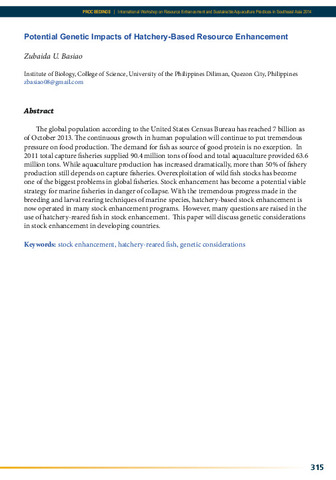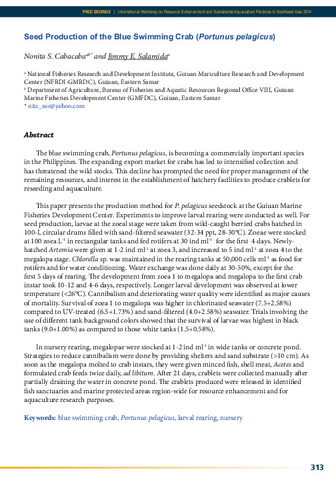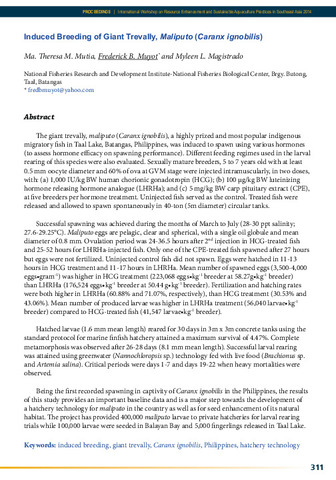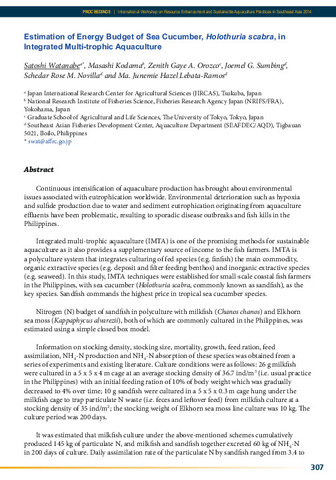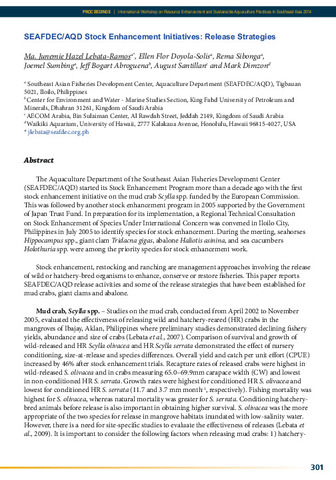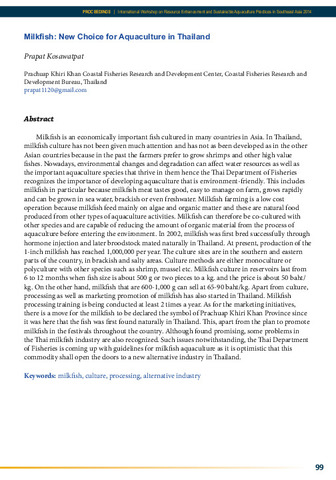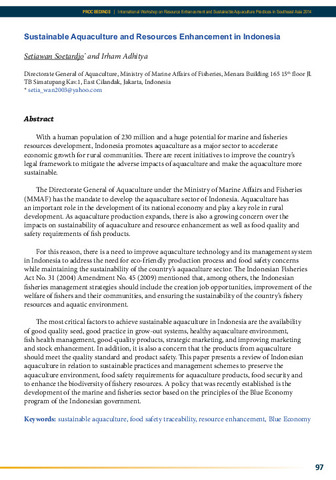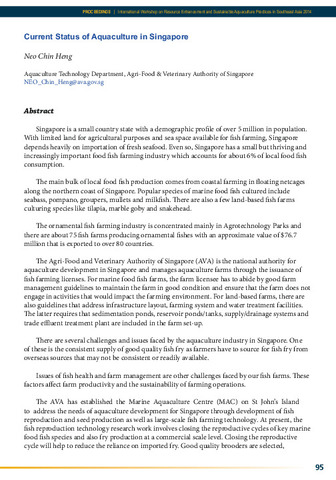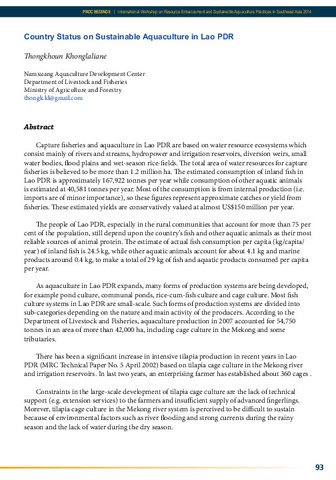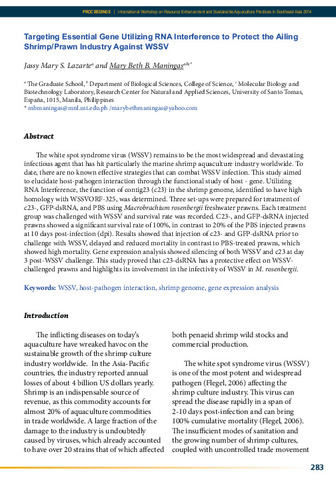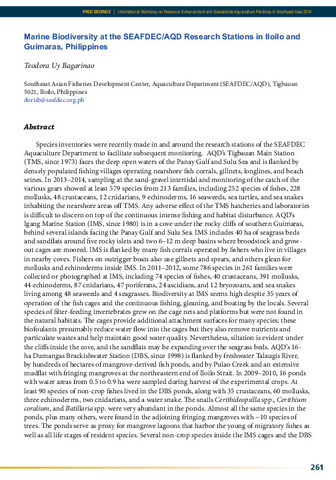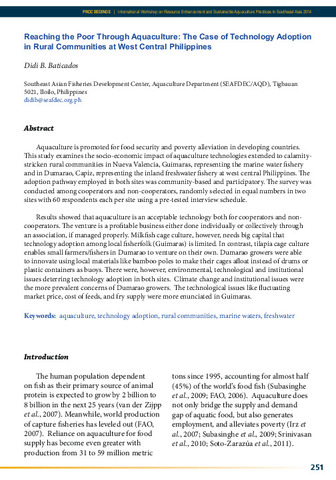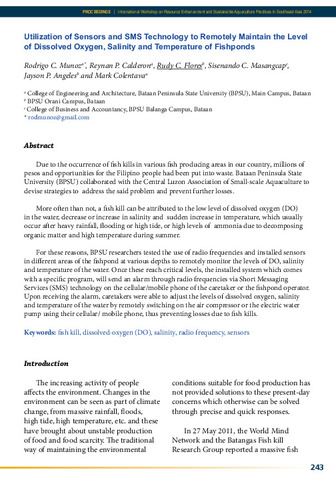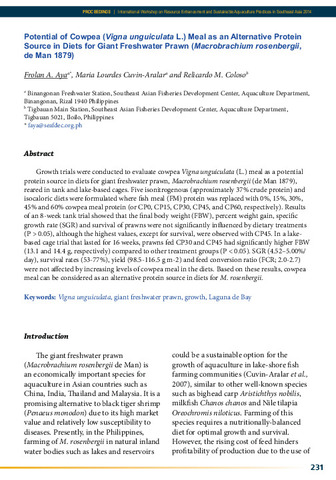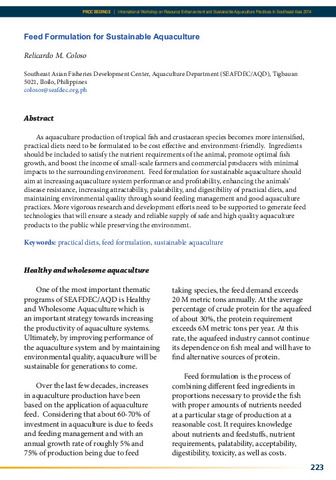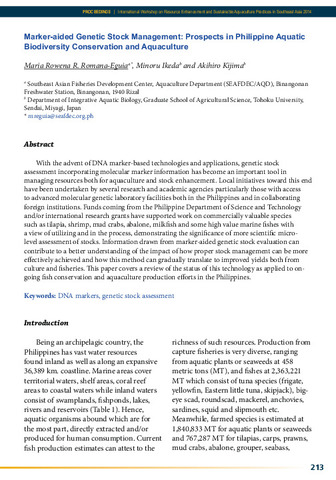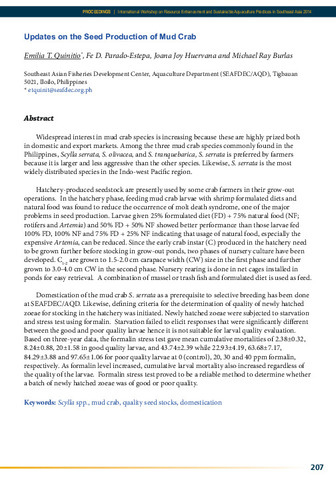Proceedings of the International Workshop on Resource Enhancement and Sustainable Aquaculture Practices in Southeast Asia 2014 (RESA): Recent submissions
Now showing items 21-40 of 56
-
Potential genetic impacts of hatchery-based resource enhancement
(Aquaculture Department, Southeast Asian Fisheries Development Center, 2015)The global population according to the United States Census Bureau has reached 7 billion as of October 2013. The continuous growth in human population will continue to put tremendous pressure on food production. The demand ... -
Seed production of the blue swimming crab (Portunus pelagicus)
(Aquaculture Department, Southeast Asian Fisheries Development Center, 2015)The blue swimming crab, Portunus pelagicus, is becoming a commercially important species in the Philippines. The expanding export market for crabs has led to intensified collection and has threatened the wild stocks. This ... -
Induced breeding of giant trevally, maliputo (Caranx ignobilis)
(Aquaculture Department, Southeast Asian Fisheries Development Center, 2015)The giant trevally, maliputo (Caranx ignobilis), a highly prized and most popular indigenous migratory fish in Taal Lake, Batangas, Philippines, was induced to spawn using various hormones (to assess hormone efficacy on ... -
Post-larval rearing strategies in sandish (Holothuria scabra) culture
(Aquaculture Department, Southeast Asian Fisheries Development Center, 2015)Various post-larval rearing methods were compared to determine which scheme would give the most yield of newly settled (visible) juvenile stage (> 1mm body length). Five types of postlarval rearing methods were tested: T1- ... -
Estimation of energy budget of sea cucumber, Holothuria scabra, in integrated multi-trophic aquaculture
(Aquaculture Department, Southeast Asian Fisheries Development Center, 2015)Continuous intensification of aquaculture production has brought about environmental issues associated with eutrophication worldwide. Environmental deterioration such as hypoxia and sulfide production due to water and ... -
Responsible shrimp culture through ecological approach
(Aquaculture Department, Southeast Asian Fisheries Development Center, 2015)Aquaculture is the fastest food-producing sector. It is the farming of aquatic organisms, like crustaceans, fish, molluscs and plants. Culture of aquatic organisms, particularly shrimps, is usually done in earthen ponds ... -
SEAFDEC/AQD stock enhancement initiatives: release strategies
(Aquaculture Department, Southeast Asian Fisheries Development Center, 2015)The Aquaculture Department of the Southeast Asian Fisheries Development Center (SEAFDEC/AQD) started its Stock Enhancement Program more than a decade ago with the first stock enhancement initiative on the mud crab Scylla ... -
Milkish: new choice for aquaculture in Thailand
(Aquaculture Department, Southeast Asian Fisheries Development Center, 2015)Milkfish is an economically important fish cultured in many countries in Asia. In Thailand, milkfish culture has not been given much attention and has not as been developed as in the other Asian countries because in the ... -
Sustainable aquaculture and resources enhancement in Indonesia
(Aquaculture Department, Southeast Asian Fisheries Development Center, 2015)With a human population of 230 million and a huge potential for marine and fisheries resources development, Indonesia promotes aquaculture as a major sector to accelerate economic growth for rural communities. There are ... -
Current status of aquaculture in Singapore
(Aquaculture Department, Southeast Asian Fisheries Development Center, 2015)Singapore is a small country state with a demographic profile of over 5 million in population. With limited land for agricultural purposes and sea space available for fish farming, Singapore depends heavily on importation ... -
Country status on sustainable aquaculture in Lao PDR
(Aquaculture Department, Southeast Asian Fisheries Development Center, 2015)Capture fisheries and aquaculture in Lao PDR are based on water resource ecosystems which consist mainly of rivers and streams, hydropower and irrigation reservoirs, diversion weirs, small water bodies, flood plains and ... -
Targeting essential gene utilizing RNA interference to protect the ailing shrimp/prawn industry against WSSV
(Aquaculture Department, Southeast Asian Fisheries Development Center, 2015)The white spot syndrome virus (WSSV) remains to be the most widespread and devastating infectious agent that has hit particularly the marine shrimp aquaculture industry worldwide. To date, there are no known effective ... -
Marine biodiversity at the SEAFDEC/AQD research stations in Iloilo and Guimaras, Philippines
(Aquaculture Department, Southeast Asian Fisheries Development Center, 2015)Species inventories were recently made in and around the research stations of the SEAFDEC Aquaculture Department to facilitate subsequent monitoring. AQD s Tigbauan Main Station (TMS, since 1973) faces the deep open waters ... -
Reaching the poor through aquaculture: The case of technology adoption in rural communities at west central Philippines
(Aquaculture Department, Southeast Asian Fisheries Development Center, 2015)Aquaculture is promoted for food security and poverty alleviation in developing countries. This study examines the socio-economic impact of aquaculture technologies extended to calamitystricken rural communities in Nueva ... -
Utilization of sensors and SMS technology to remotely maintain the level of dissolved oxygen, salinity and temperature of fishponds
(Aquaculture Department, Southeast Asian Fisheries Development Center, 2015)Due to the occurrence of fish kills in various fish producing areas in our country, millions of pesos and opportunities for the Filipino people had been put into waste. Bataan Peninsula State University (BPSU) collaborated ... -
Application of the United States Soybean Export Council program's soy-optimized floating feeds and low volume, high density cage aquaculture technologies
(Aquaculture Department, Southeast Asian Fisheries Development Center, 2015)The United States Soybean Export Council s (USSEC) Soy-In-Aquaculture (SIA) project in the Philippines introduced the Low Volume High Density (LVHD) cage culture production methodology in 2003. The aim of this technology ... -
Potential of cowpea (Vigna unguiculata L.) meal as an alternative protein source in diets for giant freshwater prawn (Macrobrachium rosenbergii, de Man 1879)
(Aquaculture Department, Southeast Asian Fisheries Development Center, 2015)Growth trials were conducted to evaluate cowpea Vigna unguiculata (L.) meal as a potential protein source in diets for giant freshwater prawn, Macrobrachium rosenbergii (de Man 1879), reared in tank and lake-based cages. ... -
Feed formulation for sustainable aquaculture
(Aquaculture Department, Southeast Asian Fisheries Development Center, 2015)As aquaculture production of tropical fish and crustacean species becomes more intensified, practical diets need to be formulated to be cost effective and environment-friendly. Ingredients should be included to satisfy the ... -
Marker-aided genetic stock management: prospects in Philippine aquatic biodiversity conservation and aquaculture
(Aquaculture Department, Southeast Asian Fisheries Development Center, 2015)With the advent of DNA marker-based technologies and applications, genetic stock assessment incorporating molecular marker information has become an important tool in managing resources both for aquaculture and stock ... -
Updates on the seed production of mud crab
(Aquaculture Department, Southeast Asian Fisheries Development Center, 2015)Widespread interest in mud crab species is increasing because these are highly prized both in domestic and export markets. Among the three mud crab species commonly found in the Philippines, Scylla serrata, S. olivacea, ...

